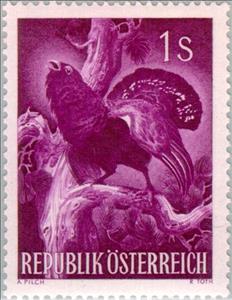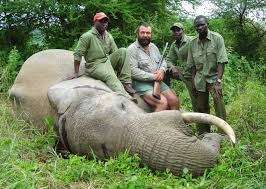Stamp: Western Capercaillie (Tetrao urogallus) (Austria 1959)
Western Capercaillie (Tetrao urogallus) (Austria 1959)
20 May (Austria ) within release Hunting congress goes into circulation Stamp Western Capercaillie (Tetrao urogallus) face value 1 Austrian schilling
| Stamp Western Capercaillie (Tetrao urogallus) in catalogues | |
|---|---|
| Michel: | Mi:AT 1062 |
| Yvert et Tellier: | Yt:AT 904 |
Stamp is horizontal format.
Also in the issue Hunting congress:
- Stamp - Western Capercaillie (Tetrao urogallus) face value 1;
- Stamp - European roe deer (Capreolus capreolus) face value 1.50;
- Stamp - Wild boar (Sus scrofa) face value 2.40;
- Stamp - Red Deer (Cervus elaphus) face value 3.50;
Stamp Western Capercaillie (Tetrao urogallus) it reflects the thematic directions:
Birds (Aves), a subgroup of Reptiles, are the last living examples of Dinosaurs. They are a group of endothermic vertebrates, characterised by feathers, toothless beaked jaws, the laying of hard-shelled eggs, a high metabolic rate, a four-chambered heart, and a strong yet lightweight skeleton. Birds live worldwide and range in size from the 5 cm (2 in) bee hummingbird to the 2.75 m (9 ft) ostrich. They rank as the class of tetrapods with the most living species, at approximately ten thousand, with more than half of these being passerines, sometimes known as perching birds. Birds are the closest living relatives of crocodilians.
Hunting is the human practice of seeking, pursuing, capturing, or killing wildlife or feral animals. The most common reasons for humans to hunt are to exploit the animal's body for meat and useful animal products (fur/hide, bone/tusks, horn/antler, etc.), for recreation/taxidermy (see trophy hunting), although it may also be done for non-exploitative reasons such as removing predators dangerous to humans or domestic animals (e.g. wolf hunting), to eliminate pests and nuisance animals that damage crops/livestock/poultry or spread diseases (see varminting), for trade/tourism (see safari), or for ecological conservation against overpopulation and invasive species.
A conference is a meeting, often lasting a few days, which is organized on a particular subject, or to bring together people who have a common interest. Conferences can be used as a form of group decision-making, although discussion, not always decisions, is the primary purpose of conferences. The term derives from the word confer.
Animals are multicellular, eukaryotic organisms of the kingdom Animalia (also called Metazoa). All animals are motile, meaning they can move spontaneously and independently, at some point in their lives. Their body plan eventually becomes fixed as they develop, although some undergo a process of metamorphosis later on in their lives. All animals are heterotrophs: they must ingest other organisms or their products for sustenance.




